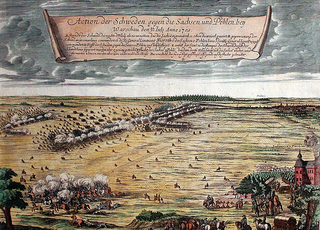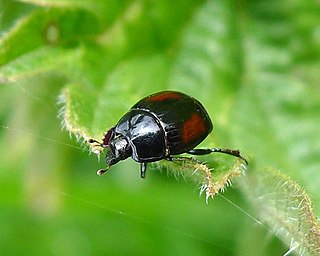
The Phalacridae are a family of beetles commonly called the shining flower beetles, They are often found in composite flowers. They are oval-shaped, usually tan, and about 2 mm in length. Most species feed on fungus, although a number feed on flower heads.

Gustav von Paykull was a Swedish friherre and Marshal of the Court, ornithologist, and entomologist.

Zacladus is a genus of minute seed weevils in the beetle family Curculionidae. There are about 13 described species in Zacladus.

The Battle of Warsaw was fought on 31 July 1705 near Warsaw, Polish–Lithuanian Commonwealth, during the Great Northern War and Swedish invasion of Poland (1701–1706). The battle was part of a power struggle for the Polish–Lithuanian throne. It was fought between Augustus II the Strong and Stanisław Leszczyński and their allies. Augustus II entered the Northern war as elector of Saxony and king of the Polish–Lithuanian Commonwealth, and had formed an alliance with Denmark–Norway and Russia. Stanisław Leszczyński had seized the Polish throne in 1704, with the support of the Swedish army of Charles XII of Sweden. The struggle for the throne forced the Polish nobility to pick sides; the Warsaw Confederation supported Leszczyński and Sweden, and the Sandomierz Confederation supported Augustus II and his allies. The conflict resulted in the Polish civil war of 1704–1706.

Melandryidae is a family of beetles in the superfamily Tenebrionoidea. Members of the family are found worldwide, with around 420 species in 60 genera. Larvae and adults are generally associated with rotting wood and wood-decomposing fungi.

Leiopus is a genus of longhorn beetles of the subfamily Lamiinae.

Rhizophagus is a genus of beetles in the family Monotomidae.

Leiopus punctulatus is a species of longhorn beetles of the subfamily Lamiinae. It was described by Paykull in 1800, and is known from Europe. The beetles measure 6-8 millimetres in length, and can live for approximately 1–2 years. They inhabit poplar trees, especially the white poplar, but also Populus tremula and Populus nigra. The species is endangered in Central Europe due to a decrease in the white poplar population.

Lythraria salicariae is a species of Chrysomelidae family, that is common in the Palaearctic realm east to Korea.

Atholus is a genus of clown beetles in the family Histeridae. There are more than 70 described species in Atholus.

Liotrichus is a genus of beetles in the family Elateridae. The species of this genus are found in Eurasia, North America, and southern Africa.

Orithales is a genus of beetles belonging to the family Elateridae.
Xylophilus is a genus of beetles belonging to the family Eucnemidae.

Phalacrus is a genus of beetles belonging to the family Phalacridae.
Ilyobates is a genus of beetles belonging to the family Staphylinidae.













